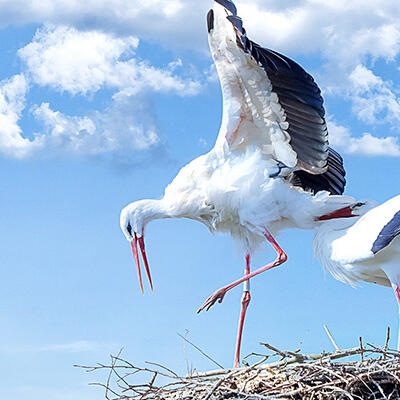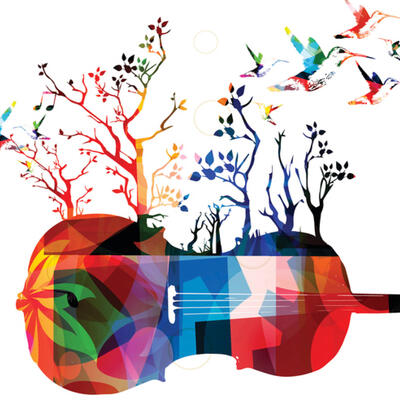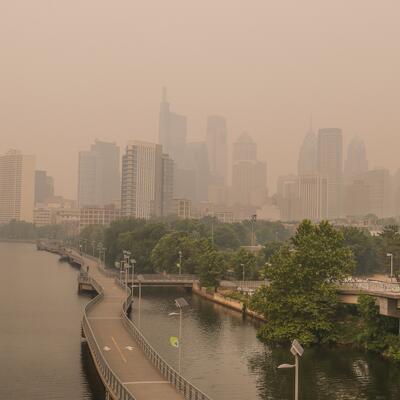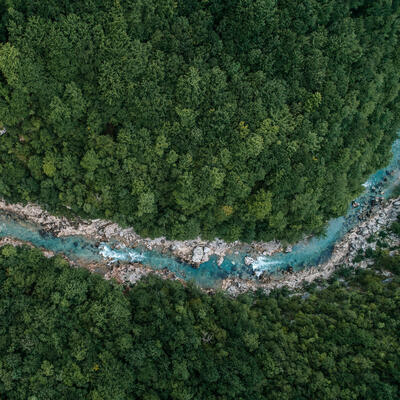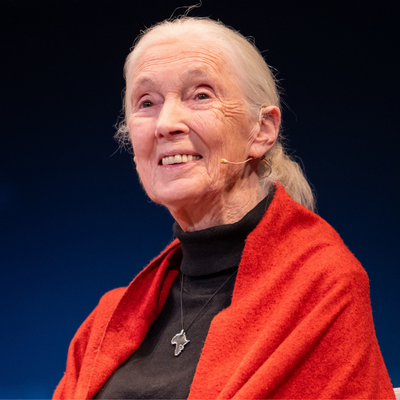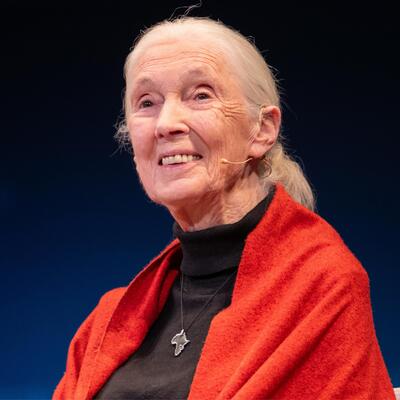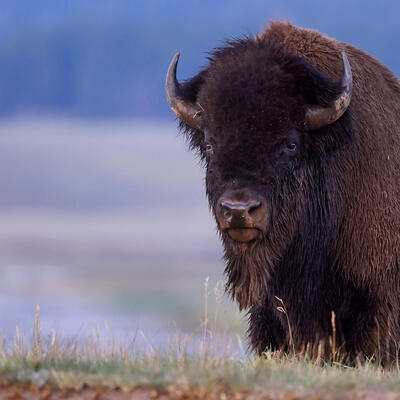
Stop, Listen, What’s that Sound?
Guests
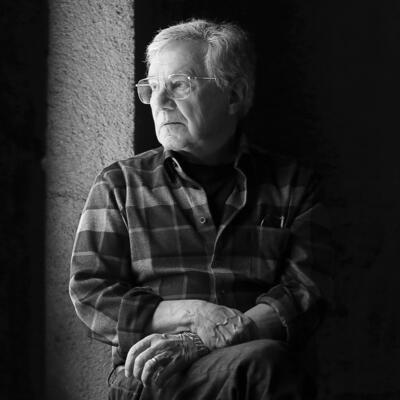
Bernie Krause
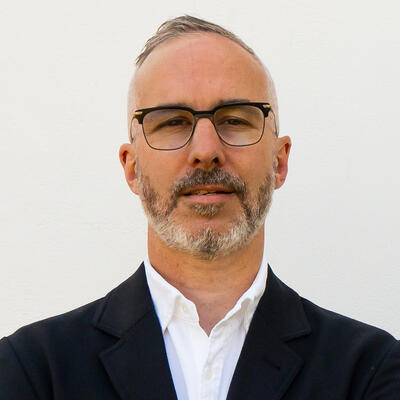
Dan Hill
Summary
Every place we inhabit has its own tapestry of sound, whether you’re hiking through the woods or sitting in a cafe with a friend. Those layers of sound are what make up the soundscape, or sounds heard in a particular location considered as a whole. But as the planet warms, that soundscape is changing. And most of that change is due to the staggering loss of biodiversity. According to the World Wildlife Fund, we’ve lost 69% of wildlife populations since 1970.
Bernie Krause is a musician and soundscape ecologist who has been recording wild soundscapes since the 1970s and has an audio archive of over 15,000 species. Many of those recordings capture soundscapes that no longer exist. Krause says, “The density and diversity of wildlife of focal wildlife, birds, insects, frogs and some mammals has changed radically.”
In the California Sierras, there is an area called Lincoln Meadow. In 1988, Bernie Krause recorded before and after it was logged. The logging company used a process called “selective logging,” which minimized the visual loss of trees. And it worked. To the eye, Lincoln Meadow looked very much the same. But the audio recording told a very different story. Krause says, “There didn’t seem to be a stick or a tree out of place. But to the ear the difference was astounding. It was so quiet and so scary.”
Krause has been described as the father of bioacoustics, which is the study of the production, transmission and reception of animal sounds. He has also helped develop the language used to describe different aspects of the soundscape with three terms: Geophony describes natural sounds made by a habitat but not the living creatures within the habitat. Biophony describes the collective sounds of all the living things in a particular place. Anthropophony describes the sounds that come from humans – organized sound like music and language, and chaotic sound such as construction or traffic.
In the biophony, Krause discovered that the sounds animals create tend to exist in particular frequency ranges, like those of instrument sections in an orchestra. He recalls, “I was in my tent one night, listening to the sounds around me. And I've been up for like 30 hours or something like that. And the soundscape, the biophony, sounded to me like it was organized.” He then took that sound and was able to see it visually on a spectrogram, which is a graphic illustration of sound. Sure enough, he was right. Krause says, “The insects were in one niche. The birds were in another niche. The mammals were in another niche, the amphibians in their frequency range. And all of these voices seem to blend together.”
While climate change is altering the sound of the natural world, our attempts to mitigate the effects will change the sound of urban centers. As more and more aspects of our lives are electrified, there will be a change to directly influence the sound of our cities. The biggest example is transportation. Electric cars and micro-mobility vehicles will remove some of the noise that has become synonymous with life in urban spaces. Since EVs need to make some sound when traveling under 20 miles per hour, carmakers have turned to sound designers and composers to create that sound. BMW hired Hollywood composer Hans Zimmer to create some sound for one of their EVs.
People often think about sound in a negative way and want to reduce the sounds that can be annoying or even harmful. Dan Hill, Director of the Melbourne School of Design, believes we should think about sound in a positive way. Think about all of the sound that makes different places unique. Hill says, “I’ve been trying to convey life and joy and richness in culture. We want certain noises to step forward.”
Highlights:
2:35 Bernie Krause on the soundscape of Lincoln Meadow before and after logging
8:46 Defining geophony, giophony and anthropophony
12:21 How animal sounds inhabit different frequency niches in the sonic field
15:33 Bernie Krause on the emotional toll of his work
16:41 Bernie Krause’s personal experience escaping a climate fueled fire
21:27 How climate disruption is changing the geophony
24:08 How sound can be used to measure changes do to climate
25:16 The sound of a melting glacier
28:48 Dan Hill on the changing soundscape in urban spaces
31:14 How EVs might change the soundscape
Related Links:
What Does Climate Change Sound Like?
How Cities Will Sound in the Future
The Great Animal Orchestra
Wild Sanctuary
City of Sound
Full Transcript
Note: Transcripts are generated using a combination of automated software and human transcribers, and may contain errors. Please check the actual audio before quoting it.
Ariana Brocious: This is Climate One. Every place we inhabit has its own tapestry of sound. But as the planet warms and we lose biodiversity, that sound is changing.
Bernie Krause: The density and diversity of wildlife, birds, insects, frogs and some mammals has changed radically.
Ariana Brocious: In urban centers, our efforts to mitigate the climate crisis will also have an effect on that soundscape. Maybe for the better.
Dan Hill: If we reduce the amount of car noise, say, then we hear coffee machines and you can hear your neighbors and you hear birds singing. The sound of the city comes forward.
Ariana Brocious: Will we listen to the message our world is sending us, or will we tune it out?
Bernie Krause: When an environment is healthy the sounds are defined in these very carefully illustrated niches. When it’s under stress that all breaks apart.
Ariana Brocious: Stop, Listen, What’s that Sound? Up next on Climate One.
Ariana Brocious: This is Climate One. I’m Ariana Brocious.
Greg Dalton: And I’m Greg Dalton
Ariana Brocious: We’re surrounded by sounds all day long. But how often do we really stop and listen to our environments?
Greg Dalton: Right. Whether you’re hiking through the woods or sitting in a cafe with a friend, there is an endless collection of sounds that make up those places. And not only are they a part of our sensory experience, but they can give us vital information about the health of our ecosystems.
Ariana Brocious: Good point. Climate disruption is having an effect on the sound of the natural world. A big part of that is due to the loss of biodiversity. There has been a 69% reduction in wildlife populations since 1970, according to the World Wildlife Fund.
Greg Dalton: That’s a staggering figure. And numbers like that are hard to grasp…what does that really mean? Hard to fathom. Hearing these changes can help. To find out just how the natural soundscape has changed and what can be learned from that change, I spoke with musician and soundscape ecologist Bernie Krause.
Ariana Brocious: Krause has been described as the father of bioacoustics, which is the study of the production, transmission and reception of animal sounds. He’s been recording wild soundscapes since the 1970s and has an audio archive of more than 15,000 species.
Greg Dalton: In 1988 a forested area in the California Sierras called Lincoln Meadow was harvested using a process called selective logging, which minimized the visual impact of fewer trees. But audio recordings Bernie Krause made before and after that logging tell a very different story.
Bernie Krause: I went up there every summer to capture that sound because it was such a pristine beautiful place. It's right at the top of Yuba Pass for those who are interested in it just north of Truckee. And I asked the logging company that had a lease on that land because they told the residents around that area that they were gonna do a new model of logging called selective logging taking out a tree here and there. It was relatively new at that time. And that there be no environmental impact as a result. And I said fine I said can I go up and record before you do that. And I did I went up in June, right on the solstice of 1988, recorded that habitat in the Sierras at about 6700 feet. And that summer the logging company did their selective logging bit and I came back exactly a year later under the same conditions and recorded again. And what I found was that not only where there are a lot of birds there, but they weren’t singing very much. And even though with a photograph the place looked unchanged. There didn’t seem to be a stick or a tree out of place. But to the ear the difference was astounding. It was so quiet and so scary. Because even though they just took out a few trees the biophony really changed.
Greg Dalton: We’re constantly immersed in sound and yet so few really listened to their environments or their surroundings. And you point out in your book The Great Animal Orchestra that we don't even really have the language to describe sound. You’ve dedicated your life to capturing sound. How do you describe it what is it mean to you?
Bernie Krause: Oh, it depends on what kind. And I do make a distinction in the book between noise and signal. Signal being that which is important information for us to have. Whether it's musical or natural sound or just information that you and I are discussing right now. That’s signal. Noise is distraction. And noise can come in any form. the signals of the world give us information that we need to have and it's a narrative of place it’s the narrative of time. When you get to the right kinds of noise it informs you that way. But as David Bowie said, the future belongs to those who can hear it coming. And I think we got to pay some attention to that because we can hear the changes that are taking place now.
Greg Dalton: Right. And so much of the mainstream news media is filled with images of melting glaciers, etc. burning forest. You once wrote “A great silence is spreading over the natural world, even as the sound of man is becoming deafening.’ How did you come to that conclusion?
Bernie Krause: Well, because in my recordings over the years I’ve been recording now since 1968. My recordings over the years I'm seeing the changes over time when I go back and visit revisit these places that I've captured years before. And the density and diversity of wildlife of focal wildlife, birds, insects, frogs and some mammals has changed radically. Not only that, the flyways have been affected by the fact that spring is occurring two weeks earlier than it did when I was recording in the 90s. And so, things are really radically changed now and it's disturbing for me to really hear when I do comparisons and look at before comparison and after comparison when I first recorded and when I record now. And it's really radical it's changed all over the place. Since 1970 there was an article in the Guardian last year since 1970 over 3,000,000,000 birds have been lost in the total number of birds in North America that’s a lot of critters.
Greg Dalton: Yeah, it’s hard to fathom the scale that's happening. You helped coin the term biophony and anthropophony to help describe different aspects of the soundscape experienced on earth. Can you help explain those terms?
Bernie Krause: Sure. I was trying to figure out how to talk about the soundscape. R. Murray Schafer wrote in his book The Tuning of the World in 1977. He was a Canadian composer and naturalist. And he wrote in his book the description of the soundscape because he's the guy that came up with that term and actually gave it credence. And the soundscape to him was all of the sound that reaches our ears from whatever source. When I started to work on this in this field the sources were important to me but the sources didn't have any identification or name. There was the mechanical world that humans have introduced and sounds coming from the mechanical world and electrical world. There were sounds coming from the natural world. But how do you make the distinction? I first came up with the term biophony in my book Into a Wild Sanctuary, which came out in 1998. But when we began to work with the National Park Service and introduce the soundscape idea to National Park Service with the late Stuart Gage who was emeritus from Michigan State University. We wanted to add some other terms to it. So, the first term that we came up with was geophony. Because geophony are the sounds or the nonbiological sounds that occur on earth. The effects of wind and the trees, water in the stream the waves at the ocean shore, movement of the earth, that kind of thing. And geophony was the first sound heard on earth before living organisms ever emerged to hear them. And 550 million years ago, organisms began to emerge and they were affected by sound and they also are transmitted sounds because every living organism is able to transmit some kind of signal. We even have viruses record it which is technically living organism, but we have viruses. And we have everything from viruses to large whales. So, we’ve got it covered now. But before when I started, we didn't have it covered so much. So, geophony was the main first source of sound on earth, followed by biophony when living organisms evolved to hear and express themselves. And then finally there's anthropophony. Anthropophony being the sounds that we create some of those signals and that really is in two subclasses. The first is controlled sound like music, theater, language and things that we use to transmit information. And the second is incoherent or chaotic sound, which is noise. And that's mostly human generated. And so, we have to account for that in that way. So, those are the three elements. Geophony, biophony and anthropophony.
Greg Dalton: That's really quite compelling. Things were missing, visually focused. In 2017, you said that well over 50% of my natural sound archive recorded since 1968 comes from habitat that are now either altogether silent or where the biophonies can no longer be heard in any of their original form. Very disconcerting statement. Has the percentage of now silent biophonies grown since 2017?
Bernie Krause: Yeah, it’s really incredible. And what people are doing in Europe right now is going to a process what's called rewilding and bringing these textures back to environments that they're trying to make healthy again. They’re restoring the vegetation it's natural vegetation of these places. And things are beginning to change in some areas. In Costa Rica they’re replanting forests in a way that's more natural not having these rows of trees and so on so forth.
Greg Dalton: Repair is possible and happening.
Bernie Krause: Repair is possible in some areas if it's done right and it is happening. It's not being restored to what it was because the soundscape there aren’t the critters around the organisms around to replace what's been lost. So, that's an interesting component that hasn't yet come back. But for the most part, the vegetation is beginning to be restored and that's having a marked impact on the habitats.
Greg Dalton: And you describe the frequency range a different animal sounds occupy is similar to that of an orchestra. Can you say more about that animal --
Bernie Krause: Well, what happened is when I was in tenure working for the California Academy of Sciences in early 1980s after I got my degree. I was in my tent one night, listening to the sounds around me. And I've been up for like 30 hours or something like that. And the soundscape the biophony sounded to me like it was organized. I couldn't tell you how it was organized but it sounded like there was a coherence to it. When I came back to San Francisco to take a look at spectrogram or graphic illustration of sound. Sure enough, the insects were in one niche. The birds were in another niche. The mammals were in another niche, the amphibians in their frequency range. And all of these voices seem to blend together in a certain kind of way yet they were strategically defined in the spectrogram. And so, what I was hearing actually was occurring. What happens is we don't hear that because we don't know how sound is organized in a healthy space. But just think about that for a second. When an environment is healthy the sounds are defined in these very carefully illustrated niches. When it’s under stress that all breaks apart and especially when the human noise is an issue that's causing the stress in that habitat. And all of the critters began to search for their niches so that their voices can be heard so that they can survive. Because if your voice can’t be heard and it’s masked by some other sound the habitat is going to become stressed. And sure, enough it's like our own voices when we have a cold or something like that. When we’re sick, it shows in our voice. When a habitat is sick, it shows in its voice.
Ariana Brocious: You’re listening to a Climate One conversation about the effect that climate disruption is having on our soundscape. If you missed a previous episode, or want to hear more of Climate One’s empowering conversations, subscribe to our podcast wherever you get your pods. Coming up, how are we forcing animals to change the sounds they make?
Bernie Krause: the noise that we’re creating is really having an effect on the acoustic world, the bioacoustic world. And animals that are going to survive are those that are changing their voices to make it happen. It’s the voices are the signs of life.
Ariana Brocious: That’s up next, when Climate One continues.
Ariana Brocious: This is Climate One. I’m Ariana Brocious. Let's get back to Greg’s conversation with soundscape ecologist Bernie Krause about the changes to what we hear caused by climate disruption. They talked about the emotional weight of studying these changes and the ways humans have altered the existence of so many nonhumans.
Greg Dalton: Doing this work. How do you carry the emotional weight of not only knowing this, but immersing in the sound, hearing it.
Bernie Krause: Well, every morning I swing my legs over the side of the bed and hope there's going to be somebody out there with whom I can connect and work and inspired to continue this work. And show that the life of the natural world the way that's expressed is through that voice and it's really important for us to pay some attention to that. To the extent that we do, we’re gonna be okay to the extent that we don't we’re in bad shape. You know, there’s an author, a Western author by the name of Paul Shepard who wrote in his book The Others: How Animals Made Us Human. There is passage in the book where he says that the further we draw away from the natural world as a culture the more pathological we become. And if you don’t believe that just listen to the news.
Greg Dalton: In 2017, your home archives and equipment were destroyed in a wildfire north of San Francisco. Part of a pattern of wildfires experts say are amplified by society's use of fossil fuels. What were the sounds of that fire and how have you recovered?
Bernie Krause: Well, we have survived. I wouldn't say completely recovered because we still have nightmares about that event. We just got out by the skin of our teeth. I just happen to be up and watching television that night when I saw the leading edge of the fire on the screen channel, I think Channel 7 was the only one handling it at that point at two in the morning. When I saw the fire on the screen, I looked at the door the glass door that we have at the front of our house and it looked like that same fire, but it wasn't. The whole hillside where we lived, we had 10 acres in Glendale and the whole hillside was had just burst into flames. my wife had just had knee surgery so she was limping she just got home two nights before. And so, I had to get her to the car and the fire was so bad we never even saw the driveway because the driveway the asphalt was on fire. There was a flame we just drove right through it and luckily the gate was broken in an open position. And because if it wasn’t, we wouldn't be having this conversation right now.
Greg Dalton: Yeah, and some people died in their cars in flames. All of you, your home and equipment were destroyed. What about your sound archives?
Bernie Krause: Ah, interesting. I had got a copy of my sound we’re doing a lot of work right now, with the Cartier Foundation in Paris. And they commissioned me to transform a lot of our library certainly the scientific data field data into large-format works of art. So, I had to protect myself. I had got a copy a full copy of my archived offshore in March of 2017. The fire took place in October. And the reason I did it was twofold. One, one of the people at the Cartier Foundation said, you know, you’re having trouble with the current administration that is so anti-science and you may want to protect your material by having it offshore, which a lot of people are doing at the EPA and NOAA and so on. And so, I did I made a full copy of my archived and handed it to them and that was the thing that saved our lives and our work because otherwise everything was destroyed.
Greg Dalton: Right. At that time there was a lot of concern about data continuity and integrity. This movie that you did The Great Animal Orchestra, which premiered in Paris in 2016 will be coming to the Exploratorium in San Francisco this summer. Can you describe this and what you're trying to do is create sound as an immersive experience for people going to museum.
Bernie Krause: Well, the one thing about natural soundscapes and the work that I've discovered with it is that when people hear them, they're not culturally biased. So, these are sounds that reach across all cultures. The narrative is universal because it tells people certain things about like I said it's narrative of time and place. And it tells people that without judgment and bias. It just is what it is. And the natural world is reaching out to us because it's saying we’re alive and we are part of the life that you need to survive. What are you going to do about it? And so, it reaches kids of all ages from four, five years old because it’s animals out to people my age. And it’s so engaging it's an hour and a half piece. It has a visual form which is the sound which is are the spectrograms, which are shown in real time coming off of the soundscapes that are transmitted in the space. And it really is a mosh to life and it's quite an extraordinary thing for us, because I never thought that I would ever see something happening in that kind of format. It’s very unusual.
Greg Dalton: Sounds fascinating. I look forward to experiencing it. We know that burning fossil fuels and resulting climate disruption has reduced the number of species in the soundscape. But has it also caused animals to change their sounds that they make in what form do those changes take?
Bernie Krause: Well, sure. There are some animals that can change their voices. Birds were singing louder in urban areas that were very noisy. Whales like killer whales, for instance, or Orcinus orca were changing their vocalizations up in Vancouver and the San Juan Islands. So, they were changing their vocalizations, singing louder or vocalizing in different ways so that the timbre of their sounds carried further. And the noise that we’re creating is really having an effect on the acoustic world, the bioacoustic world. And animals that are going to survive are those that are changing their voices to make it happen. It’s the voices are the signs of life.
Greg Dalton: And you discuss the geophony or the sounds produced by nonliving elements in the natural world. How has the disrupted planet change the sound of the geophony?
Bernie Krause: Well, again that's another sound that we need and that nonhuman animals use to orient themselves. And if that sound is masked by human noise, we lose that orientation. And so, it’s really important to have those signals in clear channels so they can be heard and interpreted for what they really are.
Greg Dalton: I think of it as you know, for recently, scientists have been educating people about increased storms and hurricanes, etc. and I felt before I heard it, I felt stronger winds in the Bay Area. I was like, wow, these winds seem stronger than before, which goes to follow we’re taking energy out of the ground and putting it into the air, right. record high winds and that's part of what’s fueled the firestorms that destroyed your house. So, for me the sound that I hear is high wind that says to me, danger.
Bernie Krause: Big time. In October 17 when we were burned out the winds were 82 miles an hour that's a Cat 1 hurricane.
Greg Dalton: And recent storms has reached 100 miles an hour near my home in the Bay Area.
Bernie Krause: Sure. I’m not surprised.
Greg Dalton: In 2020 a 9 km fiber-optic cable was laid out on the Rhone glacier in Switzerland to record the sound of the melting glacier to better help scientists measure the amount of glacier melt. So, how can sound be used to help measure the changes on the planet caused by burning fossil fuels?
Bernie Krause: Well, right now we’re able to quantify the loss of many species and the ways in which they are being diminished by noise and by climate change. I mean there are all kinds of factors many permutations involved in that. And they all kind of linked to one another. So, it's happening in a, it’s almost a domino effect. You know, one system collapses then another system collapses and so on. And it’s happening all over and we’re becoming climate migrants. I mean, certainly, my wife Kath and I, we’ve moved 8 times since 2017. But other people who are, you know, less fortunate and really impacted by all of these things that are going on the not only climate but also the wars and stuff like that. We got to stop this stuff we’ve got to figure out a way to, you know, to become more present and supportive of life.
Greg Dalton: Let's listen to the sound of a melting glacier in Norway.
[Melting Glacier Playback]
Greg Dalton: How do you feel, Bernie Krause, when you hear that?
Bernie Krause: Kind of nervous. I want to get the snorkel. It’s not something that is very reassuring. It’s not only glaciers in Norway and Switzerland they didn't ski this year because there wasn't any snow in the Alps.
Greg Dalton: Yeah. There’s been stories about the kind of the end of winter where they went up skiing and, yeah.
Bernie Krause: I’ve got a recording of the whole body of the glacier up in near Yakutat north of glacier bay in Alaska. And I've got this Hubbard Glacier and I stuck a hydrophone down in one of the crevasses and recorded the movement of the entire not the leading-edge calving, but the movement of the entire glacier forming a moraine. And it's pretty impressive it's very low-frequency so you have to have the right kind of equipment to hear it. But it's very telling about you know how things are going since we’ve been up there and I think we did that in 2007 and a glacier has moved back almost half a mile since then.
Greg Dalton: Well, as you said we can hear the future coming and it's concerning another signal for us. What do you think our world will sound like in the future and how do you hope it will sound?
Bernie Krause: Well, yeah, I was having a discussion with Jane Goodall about hope. And I said, you know, I'm not optimistic but I'm hopeful about how things are going to sound and how things are going to be. And she said, well, you know, the only way that hope is going to be amplified is if there is action behind it. And if you're willing to take you and everybody that we talked to are willing to make the changes necessary and take the steps necessary to make those changes it’s possible that we can overcome this. We’re certainly living on Mars.
Greg Dalton: Well, Bernie Krause, it’s always a pleasure and honor to talk with you. Musician and soundscape ecologist, Bernie Krause. Thank you so much for sharing your story and your sounds on Climate One.
Bernie Krause: Thank you.
Ariana Brocious: You're listening to a conversation about our changing soundscape. This is Climate One. Coming up, how will the move towards electrification change the sound of urban centers?
Dan Hill: Once the neighborhood starts becoming this kind of audio rich, diverse and quiet in terms of infrastructures, mobility, energy, water, etc. that enables metro life to step forward and fill up with their chatter.
Ariana Brocious: That’s up next, when Climate One continues.
Ariana Brocious: This is Climate One. I’m Ariana Brocious.
The natural world isn’t the only space where the sound of the environment is responding to our fossil fueled society. Cities are filled with the sounds of cars, trucks, construction, air conditioners, and other mechanical noises. As we transition away from fossil fuels, there is an opportunity to directly influence the sounds of urban centers.
I spoke with Dan Hill, Director of the Melbourne School of Design, about how climate change has already altered the urban soundscape.
Dan Hill: I mean, that’s a question as big as cities.I mean cities obviously have been full of noise for as long as they’ve existed. Now, cities being places where we kind of bring together culture and community and commerce and things like that. And so, those things are full of noise. So, you could go back to a city 2000 years ago, 8000 years ago, 200 years ago and they’d be distinctly noisy places like it’s obviously the huge shift that we’re all aware of the post-Industrial Revolution city and the motorized city, really. So, as soon as we started bringing motors and at scale to cities whether those around factories and industrial production on then obviously later years the last couple of generations most around transport. That’s distinctly changed the audio character if you like or signature of cities. And to some extent we’ve lost a bit of diversity there because the Toyota Corollas aren’t the same in every single city wherever it is. And of course, the magnitude of that noise has increased as well because you’ve seen transport shift from less human power or sometimes animal powered modes to motors. They’re noisy, noisy things as we know and that has direct impact on health as well as environment.
Ariana Brocious: So, there’s often this misconception I think that in moving to electrified transportation which we’re hoping we will all begin to do, that that will mean quieter urban spaces, but that isn't necessarily true. Can you explain why that is?
Dan Hill: So, in both cases whether it was on that sound or carbon, we actually need to reduce the number of cars on the road, electric or otherwise. But to answer your question, it’s the same with noise as well. So, while the engine itself might be quiet for instance the large part of the noise of cars, well cars and trucks actually. Once you get above 50 kms now so I guess that’s like 30 miles an hour, the tire noise is perhaps the significant audio signature there. So, while the engine itself might be quiet or quiet-ish, those be kind of a hum of some kind. Car drivers know the tire noise is still significant. And just as with the carbon we’re increasingly finding that particles from tires are also super problematic in terms of entering the bodies entering the water and so on. So, we have every reason really to yes, electrify, we should do that for blinding the healthiest reasons. But we also need to reduce the overall amount of motorized traffic going on in general for both health and climate reasons.
Ariana Brocious: Sticking with EVs for a minute I think there’s an interesting opportunity here to change some of the soundscape of cities because as you mentioned above a certain threshold above a certain speed most cars will sound the same EV or internal combustion. But at the slower speeds EVs are really quiet, almost silent in some cases. And so much so that regulators have decided they need to make some noise to account for public safety. We've seen carmakers go different directions from having simple dissonant tones to warn people that there's a car to BMW hiring composer Hans Zimmer to sound design their EVs. And we wanted to play for you one of the sounds he came up with for the BMW.
Ariana Brocious: That's a noise use to indicate accelerating and decelerating of the engine. What do you think of these sounds?
Dan Hill: Interesting. I mean I find that quite ominous. I don’t know about you but that was, you know, I’m thinking, if I’m describing a piece of music here the adjectives I’m reaching for, spooky, ominous, foreboding. I mean which is not to say that that’s incorrect because maybe cars approaching you or accelerating perhaps we should describe them ominous. I mean there’s two questions there. One is do they need to make a noise? And let’s not assume that they do. And I think, you know, we make a noise when we’re walking and cycling particularly of course bikes too, we have a noise to some extent, not really. And therefore, bikes have bells or horns or even just shout. But you’re only going again, you know, 15, 20 kms an hour and maybe 25 kms an hour maximum on a bike. So, the way I’d answer that question is that’s about how fast cars should be going in urban environments. So, slowing cars down makes for a more convivial community or in to street life super safety. You can imagine how much better that is for everybody, kids, all people as well as those in between. So, my starting point actually is a bit of red herring to get into this thing all over the audio version of a red herring is about whether cars should make a noise or not. Because the actual answer is we just need again to diversify the number of vehicles on the street as in not have so many cars and slow them down. And therefore, they can, you know, you can basically talk to each other most of the time or have a horn or a bell like bike does. So, there’s that. And then the second part is that it’s, sorry it’s just like, yeah, what noise it should make is a big question. But I wouldn’t want it to be dominated by a Hollywood composer’s idea of what like car engines should sound like. I mean again, cities are diverse places full of a million ideas. Why is it not a lot in soundtrack why is not a big bass soundtrack, you know, why is it not, I mean it’s hard, I mean who’s to say. So, I find it a bit odd but it’s interesting it sounds so ominous maybe that’s my overlay on to it. That I find it strange to give one person in this case, you know, kind of a composer, the sound of our streets and that streets are collectively producing.
Ariana Brocious: I really like that answer. Makes you think why do they have to make noise at all. And especially because maybe it involves reconfiguring how we, you know, we’ve grown accustomed to expecting cars to make noise because they do. And so, maybe we’ve turned on blinders of a sort, you know, in terms of actually being aware, pedestrians, and if cars were slower, we wouldn’t have to be as aware we could, you know, be safer on all fronts.
Dan Hill: Yeah, exactly.
Ariana Brocious: So, one thing we’ve talked about on the show before is micromobility. Small electric vehicles like ebikes or escooters. And so, if, as we’re discussing urban spaces or to move away from being so car centric. How would those vehicles change the soundscape?
Dan Hill: Well, it’s more in a way, you know, sound is a kind of zero some going to some extent. As in if we reduce the noise of something then something else steps forward. So, if we reduce the amount of car noise, say, then we hear coffee machines and you can hear your neighbors and you hear birds singing and you also hear noisy neighbors of course, and don’t wanna pretend this whole beautiful bird song all the time. But nonetheless, the sound of the city comes forward if we reduce the soundtrack. You can think of it like a mixing desk. You have to be like having 17, 18 musicians in the room but one of them is playing so loud all the time. So, you just have to kind of slow that noise down. It reminds me of a cow bell; it’s just like we need a little less cow bell in the signature. And then the other voices can come forward. So, I think this the same to some extent what you then hear is interesting. And of course, the bikes and things like scooters and some they tend to make just a lot less noise. So, it enables you again to have kind of the ideally the richness of the audio environment the place that you live in which is then again, we have full of character and full of different languages and music and just the sound of life.
So, I do think it’s a bit like that it’s like emitting gas where we got one very over dominant instrument and it’s draining up the sound of everybody else. All of these are the most pretty much including electric vehicles like you said just slow down and puddle of much richer mix then they tend to lower the noise just to step forward. And then we got really interesting conversation about others. What is the downtown where you live sound like compared to the downtown where I live. What’s like quiet suburb where I am versus a quiet suburb where you are and what’s different about those places. And you do realize again all the full of different voices different people and different natural environments with different animals in them. That all can step forward in that. We know that that has health benefits in both directions and as much as about health actually it’s also about social life and culture and community as well, of course. But we know that the over dominant traffic noise is harming to our health whereas when people got a chance to hear more diverse sound environment their health increases in multiple ways.
Ariana Brocious: Well, we’ve been talking a lot about traffic and vehicles, but I'm curious apart from transportation what other ways our soundscape could change with the transition to renewable energy? So, I’m trying to think of other things that are fossil fuel driven that make noise maybe air-conditioners or furnaces for example. And I don't know necessarily if heat pumps are quieter but I'm curious about your thoughts on that.
Dan Hill: So, there’s a really interesting shift happening here all of these machines are getting a bit quieter as they become electric but they’re also more distributed the more at hand. Your example of a heat pump is interesting or solar cells on your roof if you have roof gets a bit sunlight and then a battery in the basement. That means your house is sort of or your home on block is working as kind of power station essentially with storage in it. It is super quiet isn’t it I mean as compared to if you imagine the power station that I grew up with in the 70s, 80s, 90s, you know, all of those things where I grew up in the north of England there’s a coal belt chain I mean literally furnaces connected to those things are full of noise and smoke and crashing engines and things. So, it’s changing radically. Once the neighborhood starts becoming this kind of audio rich diverse and quiet in terms of infrastructures, mobility, energy, water, etc. that enables metro life and including humans to kind of step forward and fill up with their chatter. Which I think I mean is so beneficial.
Ariana Brocious: Yeah, for sure. So, you've touched on some of the negative health impacts of sound. And we often think of sound a little bit in a negative way. How to limit those sounds that we’re describing like loud airplanes or jackhammers.can you tell me how else we can consider sounds in a positive way when you're describing that diversity of a city and the sounds that some people may find appealing and others may not. And just the sort of audio tapestry that can exist when there isn't one dominant note.
Dan Hill: Yeah, definitely. So, there’s this sense that when sound became this thing to be regulated. And it became thing to be regulated because of the noise because of the harm just like with smoke and air quality. So, the thing this kind of understanding that we have to regulate these things that probably like a necessary evil I guess but the people knew fairly early on that that was a bad idea but then it was just kind of the tradeoff. And it’s the same with sound and particularly the sound around vehicles in traffic that people have kind of got to acquaint where it’s kind of something has been regulated, we understand it’s not a great idea. If you live next door at a freeway you know that that’s damaging your health and so, you know, people then try to put noise barriers or they find ways of moving your house backwards or whatever but all trying to limit the noise. So, today if you live under a flight path like there’s supposed to like a curfew where the airplanes are not gonna be flying up to a certain time at night. You mean not technically but could,So, we understand this kind of tradeoff here and we regulate our way around that. Because we understand that it’s again sort of a necessary evil that we need to mitigate against. I think that’s probably the wrong starting point for noise and sound going forward because sound is followed again, as I’ve been trying to convey life and joy and richness in culture. We want certain noises to step forward I mean actually most noise in the sense.
So, that’s the kind of a flip of perspective and it’s understanding that sound is complex but interesting and it can be beneficial and is subjective how people respond to kind of different ways if you’re different people. And there are some sounds that are distinctly harmful and they are also a population wide harm just like bad air quality is. So, what we have a way forward now that is to kind of again mixing these analogies to limit the amount of noise coming from the harmful sound absolute and take it right down because electrifying all those motors that’s a huge amount of work there. It enables the other sounds to step forward. So, then we’re in this interesting question about shifting the way we think from this kind of regulating them to actually just getting rid of the sound in the first place by shifting the traffic on the streets to different mix and then electrifying the engines of the cars that are left. That enables now think, okay now what is that sound about as a place, you know, what is Austin, Texas sound like. What is St. Louis sound like, you know, that’s a much more interesting conversation. It’s kind of down to some of the neighborhood level about obviously people sound differently in different neighborhoods. There’s something interesting there as well because it’s not like all sounds are universally appealing. I mean we might joke, you know, maybe a baby gurgling is universally appealing, I don’t know, I think it probably is. But I won’t be surprise to find that some people find it distinctly distressing for numerous reasons.
There was an amazing project done a few years ago called Positive Soundscape with actually into a group of people about what sounds they found appealing and catch track in numerous places and all kinds of sounds, you know, like the sound of a washing machine which is actually appealing to some people. The sound of a jackhammer is strangely appealing to some people. You know, there’s not like there’s a universal palate that we’re all tuned towards. Just like there’s no one piece of music that everybody universally agrees on. So, I think that’s much more interesting as a way of stepping forward and enables us to sort of shift the regulation out of the way. The regulation becomes how do we incentivized electric vehicles and reduce traffic as opposed to having to regulate the externality of all of that stuff the noise the incessant noise and blocks everything else out. And so, the thing that we might find interesting to step into the space is the sound of nature which is often something that in an urban environment we don’t tend to think about one thing that we have suffered from due to noise is traffic noise has really reduced the amount of bird song and diverse bird species kind of what’s called bird species richness, I guess, _____ . And it seems like lots of researchers have found out that increase traffic noise then bird song goes down almost in inverse proportion. You decrease traffic noise bird song comes up particularly diverse bird song. And this it looks like and maybe one of those sort of exception to the rule I just said as in it could be that it’s beneficial for all humans to hear bird song as far as we can tell. And it really significantly increases in health directly to your mental health the more birds you hear the more singing they’re doing and you recover from sickness quicker and so on and so on. But there’s an amazing bit of research done in Europe it looks across about 26,000 Europeans, so it’s a big study. And they found the effect of bird’s species richness on life satisfaction is bigger than income. So, essentially you get a 10% increase in life satisfaction your personal life satisfaction as you increase bird species richness around. And that’s about one and a half times more than a proportional similar increase in your income.
Ariana Brocious: Oh, that’s really amazing.
Dan Hill: I know, it is amazing. And it makes you wonder what on earth are we doing. Why are we placing this everything on income when we could just actually increase the number of birds.
Ariana Brocious: Well to that point I’m curious if we there’s in the climate space there’s a lot of attention paid to planting more trees there’s a way of, you know, pulling down carbon and improving air quality locally. But what about just increasing green spaces in general in cities and does that what is that do for the soundscape of urban spaces?
Dan Hill: Yeah, I mean a huge amount because green spaces soften the sound, I mentioned an urban environment is pretty hard without green spaces. And you will know about sound it loves to bounce around hard spaces just like heat does. So, it’s an acoustically noisy environment, put it that way, if it’s hard, if it’s tarmac and it’s stone and so on and glass. The more we soften that up then that sound dissipates, so, you know, increase trees they filter noise beautifully actually. That’s just they do with heat they also reduce the amount of heat temperature by 4 or 5 degrees depending on where you are. But they do the same. With wind they dissipate that and they also do the same with sound. So, on that alone just creating a kind of acoustically richer environment increasing green with just a huge amount of birds kind of a richer soundscape. And then equally, what I think to my previous point is you know then also increasing the sound of nature. If you’re planting the right plants so you’re planting pollinators and things and you’re getting the birds and you’re getting the insects that birds are attracted to. If you’re getting flowers and pollinators in the same place with the right kind of trees and of course that’s how you increase your bird species. But what you can’t do is also have a ton of traffic noise going on at the same time. So, those things again are kind of proportional but it’s about the space that it takes again you can’t have a street that’s full of cars and trees. Something has to give there. So, that’s why this huge immense project all over the world, Paris, Barcelona, here in Melbourne the same in the US are beginning to swap out parking spaces for greener environments for street trees and so on. It’s bit of a health it’s a bit of our community life it’s bit of a safety it’s a bit of a security. I mean it’s just a win win win win on every single point. They are also better acoustic and they also tend to attract the sense of nature that’s why I said it’s really positive to people in numerous places.
You’re the director of the Melbourne School of Design and I’m curious in designing urban spaces. I would guess that the top priorities are aesthetics and functionality, Is sound design a consideration and if not, why not?
Dan Hill: you're absolutely right. Sounds traditionally has come down the pecking order when it comes to the sort of the list of things that you're looking at when you design an urban space or a building. Part of that is to do I mean there’s a long history to that to some extent is what the Finnish architect called this is a $50 word in Finnish but ocularcentric. So, as in like where just architects in particular are focused on the way things look. Now he wrote this book called The Eyes of the Skin which is about all of the other senses. And of course, you know, what the building feels like what it smells like what the air is like when you’re standing in it the way it spatially affect you, and of course what it sounds like are also part of the mix that are hugely affecting to us as species. So, that’s been a traditional blind spot where it’s an ocularcentric way of putting it around the way we design. And as you said, you know, aesthetics then gets reduced to the way things look aesthetics even like that of course aesthetics is just kind of the richness of culture that could include sound just as much. But it’s just being that traditional mode within the architecture product for the last 200 or 300 years. And the professionalization must move in that direction away from making things by hand and by craft which again huge benefits to those things but we lost in a sense of how we approach buildings inspections multisensory environments in that shift. So, then when this has become then this kind of tradeoff, I talked about earlier the regulatory tradeoff and planners are usually driven by again like here we got a freeway through here for functional reasons as you said. And then there might be an attempt to make it an aesthetically pleasing thing either through the civil engineering of it as a form or noise barriers or putting artwork. Right here in Melbourne there’s a great tradition of building freeways with commissioning public art alongside the freeway so that’s an amazing program. But that’s kind of a bit like putting horrible phrase but lipstick on a pig, you know, you’ve made the freeway that’s already done a ton of damage putting a really interesting artwork next to it has a tiny ameliorating effect of that. It’s kind of too late. So, yeah, I think traditionally we’ve approached this kind of very regulatory we deal with the negative externalities but we don’t address the thing we’re building in the first place, the freeway, building really aesthetically. So, that’s the shift that’s going on because we’re beginning to see again this kind of win win win benefit of public health social justice climate action and so on can also be approached as an aesthetic challenge all at the same time. That’s the approach cities are beginning to take and that means multi-sensory richness as part of the answer to that. Because we’re actually dealing within the places that people live in and how they live there wrangling with the reality of that not just kind of hovering over from 20,000 feet above and drawing a line across the mountains and freeway.
Ariana Brocious: Dan Hill is the Director of the Melbourne School of Design. Thank you so much Dan for joining us on Climate One.
Dan Hill: Thanks for inviting me. Really enjoyed the conversation.
Ariana Brocious: On this Climate One... We’ve been talking about our climate altered soundscape. Special thanks to Bernie Krause for sharing some of his sound library with us.
Climate One’s empowering conversations connect all aspects of the climate emergency. To hear more, subscribe wherever you get your pods. Talking about climate can be hard-- AND it’s critical to address the transitions we need to make in all parts of society. Please help us get people talking more about climate by giving us a rating or review. You can do it right now on your device. You can also help by sending a link to this episode to a friend. By sharing you can help people have their own deeper climate conversations.
Greg Dalton is our host and executive producer. Brad Marshland is our senior producer; Our managing director is Jenny Park. Our producers and audio editors are Austin Colón and me, Ariana Brocious. Megan Biscieglia is our production manager. Wency Shaida is our development manager. Our theme music was composed by George Young (and arranged by Matt Willcox). Gloria Duffy is CEO of The Commonwealth Club of California, the nonprofit and nonpartisan forum where our program originates. Thanks for listening.
